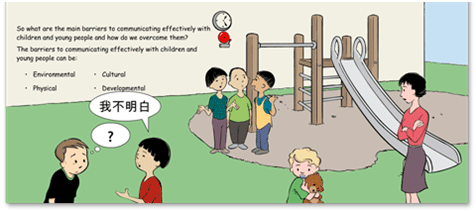Special Assignment Lesson Plan
Attention

Learning Outcomes
Upon completion of this lesson's material, students will be able
-
Identify their own interpersonal communication needs
- Identify others interpersonal needs
-
Develop effective communication strategies
-
Identify modifications to accommodate young childrens communication needs.
Teaching
The cartoon above says: The barriers to communicating effectively with children and young people can be
- Environmental
- Physical
- Cultural
- Developmental
What we know about young children is they often need a combination of communication methods to receive a message. They could need eye contact, a quiet space with few distractions, language that they understand, respect to their cultural considerations, modifications based on developmental needs and many other possible methods. We also know that children use a variety of methods to express communication such as being vocal, gesturing, facial expressions and more. However, what we really need to understand is our own methods of communication and how it will impact our work in the early childhood field. Consider these four areas of communication and what barriers impact your express and receive messages when working in the early childhood field.
Assessment
This assignment has three parts
Part 1
Identify your own barriers of communication in the four areas listed. For example. I personally cannot pay attention to someone who is talking to me in a busy environment because I am easily distracted wanting to know what is going on. I do not like it when people stand too close to me but also donít enjoy being yelled at from across the room. In my family culture, we are huggers. If I donít get a hug from a family member upon arrival of a visit then I will assume something is up. Developmentally my mind is constantly thinking of twenty things at once. I will sometimes stop mid-sentence and voice another random thought that popped in my head.
In lengthy detail I want you to describe, for each area, what makes you successful at:
A) expressing and
B) receiving messages.
- Environmental
- Physical
- Cultural
- Developmental
Part 2
A - Observe a busy room full of children. Write a summary about what the environment looks like. Include if any of the staff were struggling to have a conversation with the children and if there were any barriers. What did the physical, cultural and developmental communication indicators look like?
B - Observe a specific teacher and child interaction. Write a running record observation hitting all of the four areas of effective communication. BE SPECIFIC AND OBJECTIVE.
Part 3
A - Ask someone to complete a communication assessment using the tool provided. Have this completed in a childcare or school setting of your choice. Click HERE to download the MS Word Communication Assessment.
B - After the observation is complete reflect upon the interaction. Provide a detailed summary including the following.
- Describe the child Ė What age were they and were they on track developmentally for their age? What is your understanding of language and literacy within the family and does it impact the childís development?
- What was the environmental setting like? How did the environment impact the interaction? Describe what it felt like and if there was any active barriers.
- Were there any physical, cultural or developmental considerations you had to make beforehand? Did you need to modify during the interaction based on any barriers?
- What would you do differently next time to improve the communication interaction?
All three parts of this assignment are to be written into a single document and submitted to the assignment drop box. Please be sure to include a title page and use bold titles to indicate the differnt parts of the assignment.